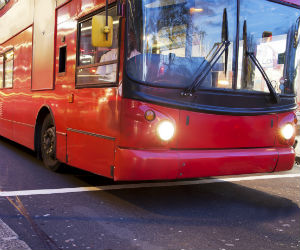Securing public transport has become a priority for nations across the globe. Here we take a look at the major requirements for mobile NVRs and DVRs, the standards that they need to confirm to, and their potential in smart city initiatives.
Securing public transport has become a priority for nations across the globe. Governments and private companies are making significant investments towards this, and initiatives such as smart cities have increased its demand. Realizing the potential, several security companies are concentrating their efforts on providing mobile surveillance solutions that leave no stone unturned.
A key ingredient of any mobile surveillance solution is the NVR or DVR. Although the recorders used in this vertical are fundamentally same as their counterparts in others, the unique environment in which they operate demands certain specific modifications. Here we take a look at the major requirements for mobile NVRs and DVRs, the standards that they need to confirm to, and their potential in smart city initiatives.
Solutions that need to be adapted for mobile environments
The nature of the vehicle largely defines the specifications for the recorder. An example is the number of video channels required, according to Wallace Ma, Executive Director of
TeleEye Group.
“We normally require one to two cameras installed in a taxi,” said Ma. “On the contrary, we would need much more cameras installed in a bus or a train compartment.”
International standards to follow when securing railway carriages
 The EN 50155 standard is common in railways
The EN 50155 standard is common in railways
but a more global standard is IEC 60571.
A new standard is expected soon.
Things do get more complex on larger public transport vehicles like buses and trains. Johan Slotte, Deputy CEO of
Teleste said that issues such as vibration and electromagnetic fields demand specific requirements in the railways, necessitating the need for rail-certified mobile DVRs and NVRs. EN 50155, a common standard covering electronic equipment used on rolling stock for railway applications, is what manufacturers are often required to adhere to.
“In addition, products and components need to fulfill certain fire and smoke certificates,” Slotte said. “The obsolescence management of the components is equally important and suppliers often need to guarantee component availability and functionality up to 30 years.”
Derek Tai, Product Manager for Rail Communications Division at
Moxa said that while the EN 50155 is an EU standard, IEC 60571 is the global standard. The latter has very specific requirements, in terms of electromagnetic compatibility (EMC), vibration, temperature, and reliability for railway equipment. For example, in most of case, “EN50155 requirement for temperature is from -25 to 70 degrees, Moxa can fulfill the highest standard requirement, from -40 to 70 degrees, which is very unique in IP camera for railway application” said Tai.
Yet another standard is expected to come out soon. “A new standard, IEC62580-2, is to be issued by the end of this year or early next year which will list train location as a part of metadata that should be taken by CCTV system” said Kevin Shen, Product Manager for Industrial Video Networking Division at Moxa. “This standard will be very specific in the functionality, applications, specifications in areas that should be covered by video surveillance cameras, and also based on the network communication standard IEC 61375.”
In other words, the IEC 62580-2 standard is expected to be more detailed in application to the extent it may note how clearly a camera can see a certain area in different lighting conditions. This in turn may help in even specifying the types of cameras to be used in different places and boost overall security.
Buses lack universal standard, prompting rail-standard adoption
When it comes to buses, the equipment is largely the same as those used in railways (due to similar harsh environmental conditions such as
 There is no international standard for buses yet,
There is no international standard for buses yet,
most installers still rely on rail standards.
temperature, vibration and dust), to the extent that those who do projects with public transportation tend to follow the same certification standard as for Rolling stock according to Ruslan Salimov, Regional Sales Manager for EMEA at
EverFocus Electronics.
Speaking of the Russian market where the company has a strong presence, Salimov noted that there is more demand to secure public transportation(busses/ambulance cars) as trains and MRT systems come with a significant level of inherent security.
“For buses, there is no international standard yet, due to the difficulties in reaching exact specifications of a vehicle” Salimov said. “System Integrators mostly look at their local regulatory requirements and compliance with EN 50155 standard. If you comply with the railways, you definitely comply for majority of other mobile projects.”
Certification requirements in different countries
In Asia there is no single certification for mobile surveillance solutions, as different countries maintain their own approval systems. Slotte pointed out certain standards other than EN 50155 that are mandated in the continent.
“Suppliers providing rail solutions should be IRIS certified, which ensures proper processes and a sufficient quality as well as obsolescence management and RAMS [Reliability, Availability, Maintainability, Safety analysis],” Slotte said.
Giving an instance of the varied certification systems in different countries, Salimov said that in Taiwan there is the Bureau of Standards, Metrology and Inspection (BSMI) that ensures the surveillance solutions in buses adhere to their specifications. But he added that regulations in buses are relatively easier than those in trains, as railways have stricter norms on energy distribution and security.
“For a MRT project in Russia, the authorities had demanded integration with UPS systems,” said Salimov. “If there is any untoward incident, the system should not go down. Instead, it should always have backup power enough for saving all the relevant data and soft reboot option.” Such demands force the solution providers to adapt their firmware and components to the end users’ surge requirements.
 Cab-related safety concerns have been on the rise
Cab-related safety concerns have been on the rise
especially in Asia. Mobile surveillance solutions
can be the right answer here.
There are also other requirements. Surveillance videos from the trains are usually exported when trains arrive at terminals, but in some countries there are certain mandates on how this video is handed over.
“Some countries in the EU won’t allow the video to be exported via any wired/wireless communication,” Tai said. “They will fetch the hard disk directly. This is because their local regulations consider the risk of modifying the video during transmission.”
There are also specific mandates on how long the video should be available, which is often different for railway and buses. According to Tai, videos should be stored for minimum three to four days to one week on the train. Videos on the bus are usually retained for a day. There are also countries that need a watermark on video clips.
Smart cities and safe cities to drive growth of mobile surveillance solutions
An increase in the number of applications, the data they supply, and an improved transmission system are definitely in the cards for mobile surveillance solution providers. More effort may also be seen towards seamless integration of different applications.
With more smart cities being implemented across the globe and improving infrastructure especially in emerging economies, there is still quite a lot of room for growth in this vertical. It’s just about the right time for security companies to focus on it too, as public concerns on safety are high. With the right government support, these solutions could go a long way in making public transport systems safer and smarter.